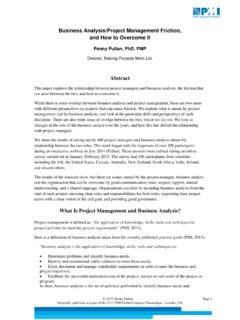Transcription of The Project Management Office
1 The Project Management Office WHITE PAPER. The Project Management Office In Sync with Strategy The Project Management Office (PMO) is easing its way into the mainstream. Yet to be truly effective, PMOs must reflect the organizational culture and strategy or risk being dismissed as an unnecessary layer of bureaucracy. Those within the profession see a clear ROI and are increasingly implementing PMOs. The State of the PMO 2010 survey of PMO leaders and other Project professionals found that 84 percent of organizations currently have one a jump of 36 percent from Companies that have made the leap are reaping benefits. Organizations with a PMO report significantly more projects coming in on time, on budget and meeting intended goals and business intent compared to those without a PMO, according to PMI's 2011 Pulse of the Profession The State of the PMO 2010 says PMOs help: Reduce failed projects Deliver projects under budget Improve productivity Deliver projects ahead of schedule Increase cost savings Not taking advantage of PMO value can be an expensive way to operate, says Michael Cooch, director of global portfolio and program Management propositions, PricewaterhouseCoopers, London, England.
2 And that view is expanding beyond the Project Management community. It is not just the PMO. practitioners that are talking about PMOs it is everyone seeing that there is something there, Mr. Cooch explains. Unfortunately, not everyone is clear on the benefits: In The Global State of the PMO: Its Value, Effectiveness and Role as the Hub of Training, 60 percent of respondents reported that the value of their PMO had been This disconnect can be caused by a number of factors, from structural problems to inadequate metrics to lack of executive support. To secure the buy-in support needed to survive and thrive, PMOs must be always be aligned with organizational strategy no matter how often it changes. Companies must also understand that PMOs are not a cure-all for organizational woes. NOT ALL PMOS ARE CREATED EQUAL. While effective PMOs share some key traits, there is no such thing as a standard approach to PMO.
3 Development. The Project Management Office There are multiple ways to classify PMOs, says Monique Aubry, PhD, professor, graduate programs in Project Management , School of Business and Management , University of Qu bec at Montr al, Qu bec, Canada. PMOs can vary based on their organizational context, structural characteristics (such as where the PMO is located within the organization), and roles or functions. These factors mean PMOs can differ greatly from organization to organization. What they all must have in common, however, is a strong foundation to help them weather the precarious early stages of the PMO's launch. Mr. Cooch estimates half of PMOs fail on their first attempt because they do not align with organizational strategy. For instance, a company might set up its PMO success criteria around budget, when the organization's overall focus is innovation. At IT giant Google, for example, delivering cost- effective and timely projects is important, but not as important as coming up with cutting-edge thought leadership.
4 The PMO has to have an environment where ideas can be created, he says. Sometimes that means the budget and schedule are lower priorities. Understanding a company's key drivers is the only way PMOs will contribute value, Mr. Cooch explains. You have to be You really have to understand the market and the organizational archetypes you are working in. How does organizational strategy tie into your strategy? . Michael Cooch, director of global portfolio and program Management propositions, PricewaterhouseCoopers, London, England PMOs vary by organization, but establishing the necessary processes and culture does not require starting from scratch each time. I do not believe PMO leaders need to consider themselves unique in the world of leadership or fostering a culture of success says Mr. Cooch. Mr. Cooch suggests all PMO leaders: 1. Err on the side of collaboration over policing to boost support and longevity.
5 2. Secure executive buy-in so the PMO's value is understood by the whole organization. 3. Ensure every member of the PMO team understands his or her individual value and the value of the PMO as a whole. One of the top differentiators of success is how well a PMO is embedded within an organization, Dr. Aubry says. She lists four factors that determine this level of integration: 1. Collaboration: The PMO should encourage collaboration between Project professionals and functional departments. 2. The Project Management Office 2. Recognition of expertise: Do the Project professionals working with the PMO improve the level of respect Project Management receives within the organization? This should also influence who works in the PMO. 3. The mission is well understood: Do those outside the PMO know its purpose? 4. Support from upper Management : Is there an executive champion who will not only communicate the mission, but will work to gain engagement from stakeholders?
6 Increasing the intensity of one or more of these variables should increase the level of embedding and, consequently, the PMO performance, says Dr. Aubry. The organization needs to put emphasis on these elements that are often put aside, rather than taking care only of technical facets of the PMO's functions and characteristics.. PMO IN ACTION. The Organization: State Auto, Columbus, Ohio, USA. The Sector: Insurance The ROI: By focusing on outcomes rather than processes, State Auto's reorganized PMO nearly tripled the number of projects that deliver on organizational strategy. The PMO at State Auto was operating in a vacuum. Small, random projects would pop up, with no consistent mechanism system to ensure projects were meeting strategic objectives, staying on budget and sticking to their original goals. Realizing it had to make major changes, the company put the PMO in charge of delivery, methodology, governance, Project portfolio Management and change Management for enterprise-wide projects.
7 State Auto's overall strategy is now revisited each year, and once a month, the PMO team analyzes how it is driving that vision through projects. Organizational units looking to launch projects are now required to build a business case that details how they align with corporate strategy. Also, teams are now required to complete Project scorecards to demonstrate this alignment. Strategy without execution is You can develop strategy, but if you cannot execute it, you can just throw it away.. Greg Ramah, State Auto's Project portfolio Management director Getting to that point has been a multi-year process for State Auto. Mr. Ramah overhauled the PMO team in 2009, replacing a team staffed primarily by those with an insurance background. 3. The Project Management Office I brought in people who understand what makes projects work, what makes Project If PMOs are not staffed well, they won't understand this.
8 Greg Ramah, State Auto's Project portfolio Management director The PMO team spent time with executives and stakeholders, including Project managers and subject matter experts, to discuss the value of the PMO, its goals and its methodologies. Mr. Ramah and his team began by working with business units enthusiastic about the PMO's changes, including IT and claims. We brought them in early and really talked to them about what they wanted to accomplish and how it meshed with what we wanted to accomplish, Mr. Ramah says. Those unites were then transformed into promoters for the PMO throughout the organization. Once they see success, they want to be involved.. Not all of State Auto's business units have been keen on its PMO's new approach. Now that they can no longer just launch a Project , says Mr. Ramah, some view it as a constraint. But the PMO team continues to work with reluctant units to bridge that gap, helping them realize the added strategic value of teaming with the PMO.
9 The PMO's efforts are having an impact. Now 90 percent of State Auto's projects are tracked within the PMO, Mr. Ramah reports, and a majority will be directly aligned to business strategies by the end of 2012. SEEING VALUE. Perhaps the biggest obstacle facing PMOs is not delivering results, but communicating them upward. Only 15 percent of Project managers who report to vice presidents of IT believed their firm recognizes the PMO as delivering significant value, according to The State of the PMO in That number increases slightly, to 22 percent, when respondents report to a CIO. And nearly 70 percent of respondents to the Global State of the PMO Study who said that their PMO's value was questioned said that it was senior Management who was skeptical. Those questions often are due to a lack of Project Management understanding in the upper ranks. Why do some organizations see the value of PMOs? This is directly related to the Project Management maturity of its leaders, not just the size of the organization.
10 Eric Morfin, PMP, senior director of the oncology business unit at Pfizer, La Jolla, California, USA. I have worked with large companies with very immature leadership and smaller organizations with very mature leaders, Mr. Morfin says. If the executive is not mature or familiar with PMOs, at least that person needs to be smart enough to hire the best PMO leader and let him or her establish the processes and culture to make a difference.. 4. The Project Management Office Executives must first establish the value of Project Management in delivering strategic results. With that foundation, they can then spread the word about why the organization needs a PMO. They should secure funding, get buy-in from different departments, and create a value proposition. That will happen with the executive support, Raed Skaf, PMP, executive manager of PMO and budgeting at Mobily, Riyadh, Saudi Arabia. Attention from the executive suite can go a long way, Mr.












